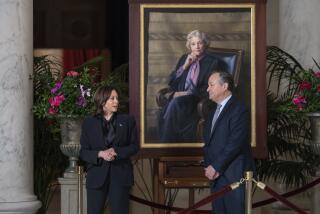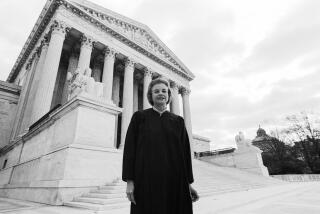Nominee Called Trailblazer Who Kept Low Profile
- Share via
WASHINGTON — As a trailblazer, Ruth Bader Ginsburg seems oddly miscast.
While she has been the leading fighter for women’s legal rights and an inspiration to feminists across the country, President Clinton’s nominee to the Supreme Court is no Betty Friedan or Gloria Steinem. By all accounts, she is painfully shy and uninterested in politics--the very opposite of the women most closely identified with the feminist movement.
In fact, according to Frank Askin, a Rutgers University law professor who has known Ginsburg since 1964, many of her friends were genuinely surprised in the 1970s when as a law professor she began arguing a series of successful landmark women’s rights cases before the U.S. Supreme Court.
“It seemed so out-of-character for her,” Askin recalls. “Ruth has always been very moderate, very cautious in her thinking. She’s no legal radical.”
As a lawyer, a law professor and an appeals court judge, Ginsburg, 60, has always been more interested in precedent than ideology, more committed to legal scholarship than to outcome. For that reason, her nomination is likely to have the support of Republicans as well as Democrats, conservatives as well as liberals.
Yet no one would dispute the dramatic impact that Ginsburg’s trailblazing legal work has had on the lives of every American woman. As Clinton noted in announcing her nomination on Monday, Ginsburg is to women’s rights what the late Justice Thurgood Marshall was to minority rights.
“She was the chief architect of getting women into the Constitution of the United States,” said Eleanor Holmes Norton, a noted civil rights attorney and congressional delegate for the District of Columbia.
As an unpaid attorney for the American Civil Liberties Union Women’s Rights Project in 1971, Ginsburg, then a law professor at Columbia University, persuaded the Supreme Court for the first time to declare a gender-based law unconstitutional under the equal protection clause of the 14th Amendment.
The case, Reed vs. Reed, which involved an Idaho law that instructed probate judges to automatically name male relatives as executors, was the first of a half-dozen cases that Ginsburg argued before the court that succeeded in establishing heightened constitutional scrutiny over gender-based classifications found in federal, state and local laws.
Judith Lichtman, executive director of the Women’s Legal Defense Fund, said that Ginsburg borrowed from minority rights cases--many of them argued by Marshall--to develop the legal theory that she argued before the court on behalf of women.
“They were novel theories at the time,” Lichtman recalled.
Yet for the enormous contribution she made to winning equality for women in the United States, Ginsburg’s low-key personality has until now prevented her from achieving the celebrity of other legal pioneers. Had the Brooklyn-born lawyer not been named as the second woman to sit on the Supreme Court, many women who benefited from her work might never have known her name.
“She’s a heroine without the cult of personality that usually surrounds heroes and heroines,” said Barbara Babcock, a Stanford University law professor and friend of the nominee. “She’s the sort of heroine who normally goes unsung.”
It was apparently her own bitter disappointment as a bright, ambitious woman unable to gain access to the same opportunities as her male peers that caused this reserved lawyer to step into the spotlight and win major victories for the modern feminist movement.
An honors graduate of Cornell University in 1954, Ginsburg attended Harvard Law School for two years, then sought to transfer to Columbia University during her third year to be with her lawyer-husband, Martin, a noted tax attorney.
According to friends, Ginsburg believed that Harvard discriminated against her by refusing to grant her a diploma because of her Columbia credits. She has told friends that the Harvard faculty at the time thought that women students were depriving qualified men of an opportunity to attend the school.
Again, after obtaining her degree from Columbia in 1959, Ginsburg encountered gender bias. Despite her outstanding academic record and obvious brilliance, no law firm would hire her as a lawyer.
Patricia A. King, a Georgetown law professor and a friend, said that Ginsburg’s early rejection as a lawyer proved to be a “searing” experience for her. “It was enough to convince her to say, ‘I’m going to right this injustice,’ ” King said.
After a brief stint as a law clerk in the early 1960s, Ginsburg began teaching civil procedure at Rutgers in 1963. The good students loved her because she challenged them; her mediocre students found her boring.
“She was dull; she always droned on in a monotone,” recalled one former student. “There was nothing exciting about her but her intellect.”
Eventually, Ginsburg’s career was swept up in the gender revolution that she helped engineer. In 1972, Columbia University Law School hired her away from Rutgers, making her the first woman law professor at the school.
At Columbia, Ginsburg became a role model for the growing number of women who began attending law school in the 1970s. A stern-looking portrait of her still hangs on the walls at Columbia, among the pictures of the many male graduates of that school who went on to make their marks on the U.S. legal system.
Always ambitious and determined, Ginsburg openly dreamed of the day that she might take her place on the federal bench alongside her peers. As she revealed Monday at the White House, her daughter, Jane, now a Columbia law school professor, acknowledged in her high school yearbook that her biggest ambition was to get her mother appointed to the Supreme Court.
In 1976, when Jimmy Carter was elected President, Ginsburg’s ambition began to focus on the position of solicitor general. Then-Atty. Gen. Griffin B. Bell said that, when he met with her to discuss a possible Justice Department appointment, she made it clear she had no interest in any job other than solicitor general--a post that was already filled.
Nevertheless, Carter appointed Ginsburg to the U.S. Court of Appeals in Washington in 1980, and she has used that position to distinguish herself as a serious-minded, independent thinker. Norton said that Ginsburg’s name would have to appear on any list of the top 10 judicial minds in the nation.
The mother of two grown children, Joan and James, Ginsburg is married to a Georgetown Law School professor who is a recognized national expert in tax law. By her own admission, Ginsburg’s husband is the cook for their family. She is an avid golfer and an opera enthusiast.
Times staff writers Ronald J. Ostrow and David Lauter contributed to this story.
More to Read
Get the L.A. Times Politics newsletter
Deeply reported insights into legislation, politics and policy from Sacramento, Washington and beyond. In your inbox three times per week.
You may occasionally receive promotional content from the Los Angeles Times.









